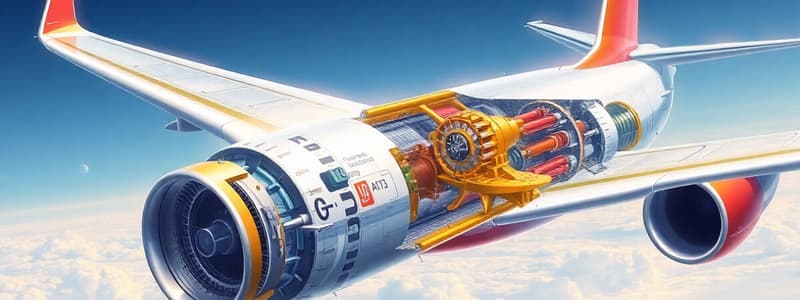Podcast
Questions and Answers
What is the primary purpose of the flap disconnect detection system?
What is the primary purpose of the flap disconnect detection system?
- To measure the performance of updraft
- To prevent flap operation in case of attachment failure (correct)
- To provide additional lift during landing
- To enhance the flap operation during takeoff
Which hydraulic powers are used for the motors operating the slats and flaps?
Which hydraulic powers are used for the motors operating the slats and flaps?
- Yellow and red for slats, blue and green for flaps
- Red and yellow for both slats and flaps
- Green and blue for slats, yellow and green for flaps (correct)
- Only green hydraulic power for both components
What happens if one SFCC becomes inoperative?
What happens if one SFCC becomes inoperative?
- Both slats and flaps will cease to operate
- Slats and flaps will operate at full speed
- Only slats will operate at half speed
- Both slats and flaps will operate at half speed (correct)
Which system provides feedback on the position of slats and flaps to the SFCCs?
Which system provides feedback on the position of slats and flaps to the SFCCs?
What is the role of the WTBs in the slat and flap system?
What is the role of the WTBs in the slat and flap system?
What happens when the flap WTB is activated?
What happens when the flap WTB is activated?
What is the operational speed of slats and flaps if one SFCC is inoperative?
What is the operational speed of slats and flaps if one SFCC is inoperative?
How do the slats and flaps respond to a failure in the hydraulic system?
How do the slats and flaps respond to a failure in the hydraulic system?
If the slat WTB is on, what can the flight crew still operate?
If the slat WTB is on, what can the flight crew still operate?
How many slats and flaps are there
How many slats and flaps are there
What’s spends signals to Ecam on slat flap position ?
What’s spends signals to Ecam on slat flap position ?
Flashcards
Slat and Flap System Components
Slat and Flap System Components
The slat and flap system consists of slats, flaps, ailerons, hydraulics, and control units, all electrically and hydraulically operated on each wing.
Slat and Flap Control
Slat and Flap Control
The flight crew uses a lever to set the position of slats and flaps, which have five possible positions.
Hydraulic Power for Slats and Flaps
Hydraulic Power for Slats and Flaps
The PCU uses different hydraulic fluids (green, blue, yellow) for slats and flaps.
WTB Activation
WTB Activation
Signup and view all the flashcards
Flap Disconnect Detection
Flap Disconnect Detection
Signup and view all the flashcards
What does the IPPU send to the ECAM?
What does the IPPU send to the ECAM?
Signup and view all the flashcards
How do slats and flaps operate if a single SFCC is inoperative?
How do slats and flaps operate if a single SFCC is inoperative?
Signup and view all the flashcards
What happens if one hydraulic system fails?
What happens if one hydraulic system fails?
Signup and view all the flashcards
Can the flight crew operate slats and flaps when the WTB is activated?
Can the flight crew operate slats and flaps when the WTB is activated?
Signup and view all the flashcards
How does the flight crew control slats and flaps?
How does the flight crew control slats and flaps?
Signup and view all the flashcards
Study Notes
Slat and Flap System Components
- Seven slats and two flaps per wing, plus two ailerons (with droop function)
- Surfaces are electrically controlled and hydraulically operated
- Flight crew controls via flaps lever on center pedestal (five positions)
- Two SFCCs (Slat and Flap Control Channels): each with one slat and one flap channel
- PCU (Power Control Unit): two independent hydraulic motors, coupled by a differential gearbox
- Motors use different hydraulic power: green/blue for slats, yellow/green for flaps
- POB (Position Override Block): locks transmission when surfaces reach a position or hydraulic power fails
- Two APPUs (Asymmetry Position & Position Units): measure asymmetry between left and right wings
- Flap Disconnect Detection System: detects attachment failure and inhibits flap operation to prevent damage
- Sensor measures excessive differential movement between inner and outer flaps
- WTBs (Warning and Triggering Brakes): activate for uncommanded surface movement (runaway, asymmetry, overspeed)
- Cannot be released in flight
- Use different hydraulic power: blue/green for slats, green/yellow for flaps
- FPPUs (Feedback Position Power Units): feedback position information to SFCCs
- IPPU (Interface Position Power Unit): sends position data to the ECAM
- Partial Operation Considerations:
- Flap WTB engaged: slats can still be operated
- Slat WTB engaged: flaps can still be operated
- One inoperative SFCC: both slats and flaps operate at half speed
- One inoperative hydraulic system: corresponding surfaces operate at half speed
Studying That Suits You
Use AI to generate personalized quizzes and flashcards to suit your learning preferences.

